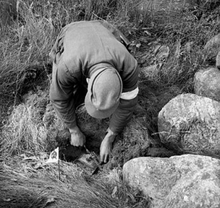Hitler teeth
The Hitler teeth (Norwegian Hitlertennene ) or Hitler stones are in a Scandinavian language tank traps which are sold in World War II in 1942 as part of the Atlantic Wall the German occupiers to shallow coastal areas of Norway were built. They are known in the vicinity of Jæren , Hå and Egersund (south of Stavanger ). They were built by hundreds of forced laborers, mainly from the surrounding area, and by prisoners of war .
Natural stone and concrete blocks, arranged as cusp lines in several staggered rows along Reichsstrasse 44, were intended to make an invasion of occupied Norway from the direction of Britain by British and Norwegian troops more difficult. On the flat sandy beach in front of it, wide minefields were created, both from anti- tank mines and with thousands of anti-personnel mines . The strip was additionally secured with barbed wire and could be illuminated in parts with spotlights. At Obrestad , on Hårr and in Vedafjell near Sirevåg , gun emplacements with underground bunkers were built.
During and after the war there were repeated accidents with fatal consequences; Children in particular were at risk because the mines looked like bars of soap and they wanted to play with them. The population also suffered from target practice that was carried out from cannon positions and also hit civilian buildings on land.
At the end of 1942 the work of the nasjonale arbeidsinnsatsen began. Natural stone blocks from a quarry near Kvalbein were used between Holmestø and Varden . In the northern part, west of Kvalbein, an additional trench six meters wide and three meters deep was dug. The workers came from Egersund and Stavanger and, in their mostly inadequate clothing, had to work more than ten hours a day with hoes and shovels and horse-drawn carts in winter. Some of them had to work there for several years. The hourly wage of the male population of all ages was 1.60 kronor per hour. The stone blocks were transported in carts or sledges. Since the military benefit of a paved stretch of beach, considering the length of the Norwegian coastline, was obviously very small at best, not only from today's perspective , it is assumed that the labor was primarily used to suppress potentially politically dangerous people from the Fylke Rogaland .
Web links
- Hå Kommune Krigsminne frå Varhaug.
- Kulturminneløypa.no, 2009: “Krigsminnevandring i Hå - Hitlertennene på Brusand”.

